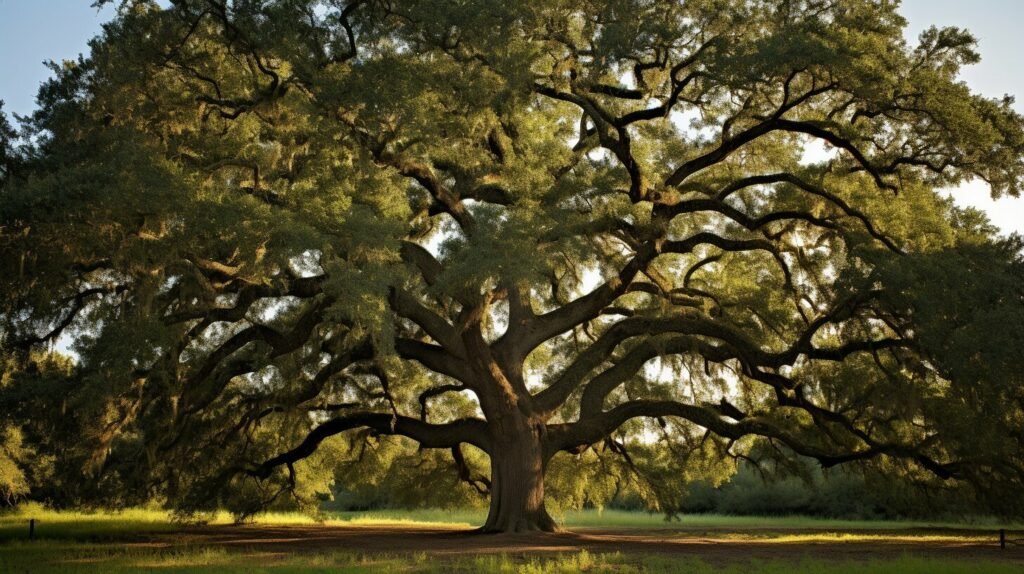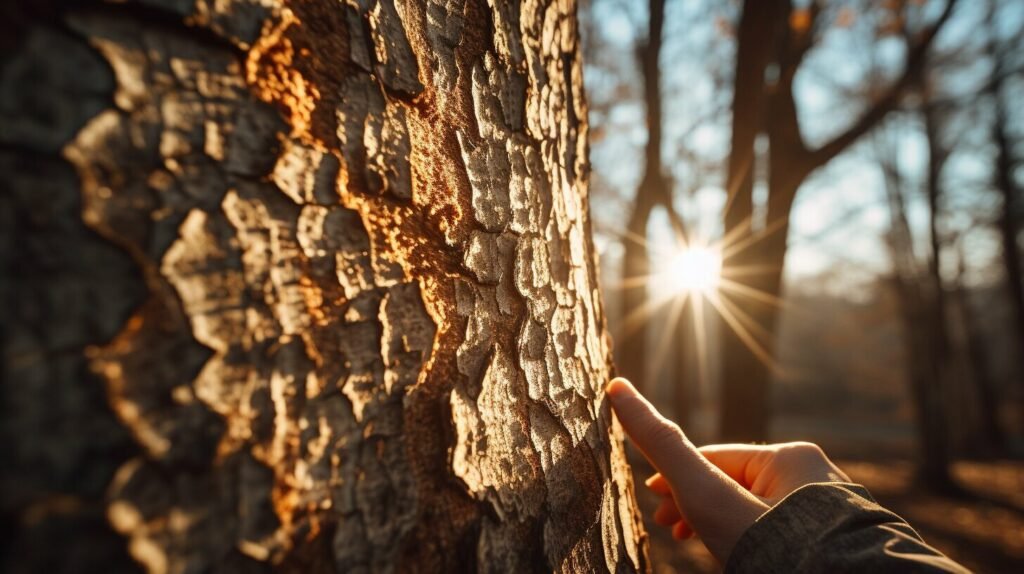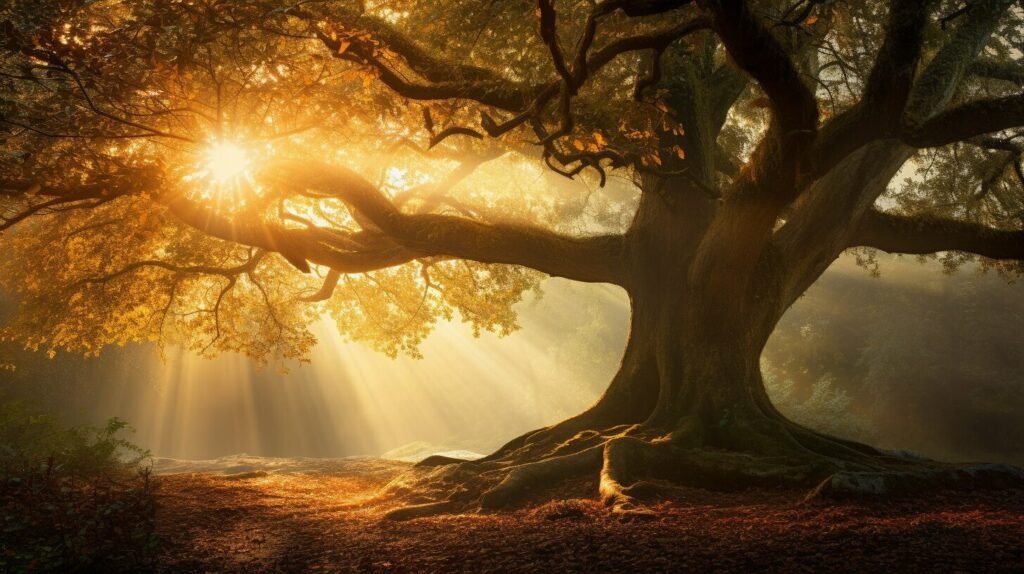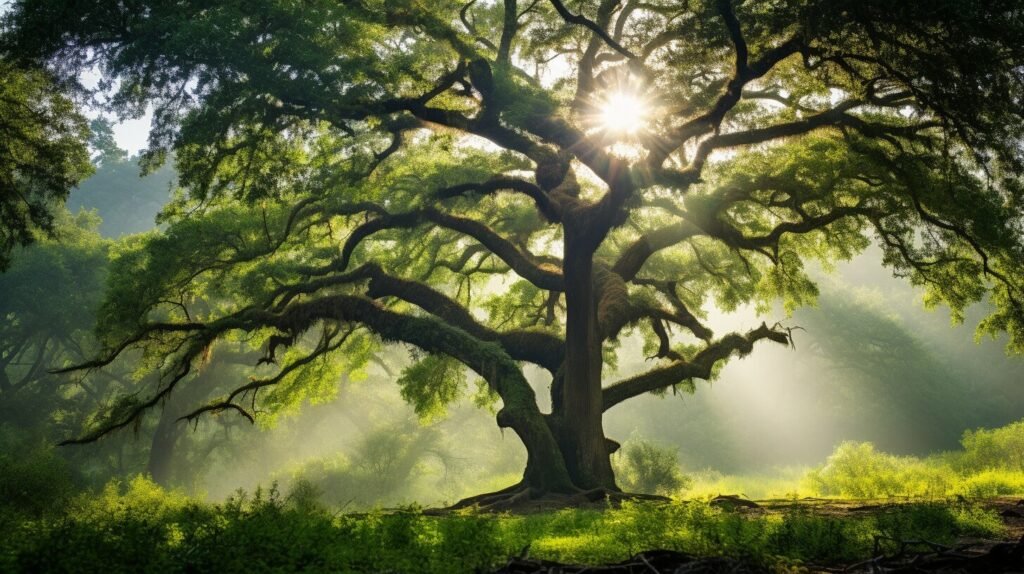Oak trees are not only majestic in appearance but also serve as a captivating subject for wildlife photography, allowing photographers to capture the essence of nature’s beauty. These iconic trees, with their unique beauty and significance, have become a favorite among photographers seeking to showcase the wonders of the natural world through their lens.
- Oak trees are a popular subject for wildlife photography and fine art landscape photography.
- Each species of oak tree has its own distinct physical characteristics and habitat preferences.
- Popular locations for oak tree photography include Yosemite Valley, Botany Bay Road, Charleston, and the Angel Oak Tree.
- Unique techniques, such as x-ray imaging, can be used to capture the beauty of oak trees.
- Consideration of lighting conditions, lens selection, and perspective choice can enhance oak tree photography.
The Unique Beauty of Oak Trees
Oak trees come in various species, each with its own distinct physical characteristics and habitat preferences, making them a fascinating subject for photographers to capture. The majesty of oak trees lies in their grandeur and the intricate details found in their bark, leaves, and acorns.
One of the most distinguishing features of oak trees is their robust and sturdy trunks, which often exhibit deep furrows and intricate patterns. This texture adds depth and interest to photographs, especially when captured up close. The leaves of oak trees are equally captivating, varying in shape and size depending on the species. Whether it’s the delicate lobed leaves of the white oak or the spiky pointed leaves of the red oak, each variety offers a unique visual appeal.
| Species | Physical Characteristics | Habitat Preferences |
|---|---|---|
| White Oak | Oval-shaped leaves with rounded tips | Well-drained soils, forests, woodlands |
| Red Oak | Pointed lobed leaves with bristle tips | Diverse habitats, often found in upland areas |
The habitat preferences of oak trees also contribute to their unique beauty. Some species thrive in moist environments and can be found near rivers, while others prefer dryer soils and can be seen in woodland areas. These diverse habitats provide photographers with countless opportunities to capture oak trees in different natural settings.

Popular Locations for Oak Tree Photography
From the breathtaking landscapes of Yosemite Valley to the enchanting Angel Oak Tree in Charleston, there are numerous locations that offer photographers the perfect backdrop for capturing the beauty of oak trees. These locations not only showcase the majestic appearance of oak trees but also provide unique settings and atmospheres that add depth and character to the photographs.
Yosemite Valley in California is renowned for its stunning natural beauty, and its oak trees play a significant role in creating captivating compositions. The valley’s towering granite cliffs, cascading waterfalls, and lush meadows provide a picturesque setting for photographers to capture oak trees in all their glory.
In South Carolina, both Botany Bay Road and Charleston offer exceptional opportunities for oak tree photography. Botany Bay Road is a hidden gem that features a scenic drive lined with moss-drenched oak trees. The winding road and ethereal atmosphere create a dreamlike setting that is perfect for evoking a sense of tranquility in photographs.
Charleston is home to the iconic Angel Oak Tree, a massive southern live oak that is estimated to be over 400 years old. This magnificent tree with its sprawling branches and impressive size serves as a captivating subject for photographers. The surrounding park also offers opportunities to capture the unique interplay of light and shadow among the oak trees.
Whether it’s the grandeur of Yosemite Valley, the enchantment of Botany Bay Road, or the timeless beauty of the Angel Oak Tree in Charleston, these locations provide photographers with endless possibilities to showcase the beauty of oak trees in their photographs.
| Location | Description |
|---|---|
| Yosemite Valley, California | Awe-inspiring landscapes with towering cliffs, waterfalls, and lush meadows. |
| Botany Bay Road, South Carolina | An ethereal atmosphere with moss-drenched oak trees along a winding road. |
| Charleston, South Carolina | Home to the iconic Angel Oak Tree and a park with captivating oak tree compositions. |
The Artistic Techniques of Oak Tree Photography
In the world of oak tree photography, artists like Arie Van ‘T Riet have pushed the boundaries by employing unique techniques, including creating x-ray images that showcase the intricate beauty of these magnificent trees. Van ‘T Riet, a former radiation physicist, utilizes his expertise to capture mesmerizing x-ray images of oak trees, revealing their hidden details and structures.
“X-ray photography allows me to explore and appreciate the hidden beauty of oak trees that the naked eye cannot see,” says Van ‘T Riet. “Through this technique, I aim to create a visual experience that evokes wonder and highlights the intricate patterns and textures found within the trees.”
To produce these captivating x-ray images, Van ‘T Riet carefully positions the oak tree specimen in front of the x-ray machine and captures the unique patterns and structures revealed by the radiation. He then digitally enhances the images with light colors to add an artistic touch, resulting in striking visuals that mesmerize viewers.
| Artistic Techniques of Oak Tree Photography | Description |
|---|---|
| X-ray Photography | Utilizes x-ray machines to capture stunning images of oak trees, showcasing their hidden details and structures. |
| Digitally Enhanced | Images are enhanced with light colors to add an artistic touch and create visually striking visuals. |
| Highlighting Patterns and Textures | Emphasizes the intricate patterns and textures found within oak trees, creating a visual experience that evokes wonder. |
These unique artistic techniques allow photographers to capture the oak tree’s beauty in a way that goes beyond traditional photography, offering viewers a fresh perspective and a deeper appreciation for these majestic trees. Whether through x-ray images or other innovative methods, photographers continue to explore new ways to portray the beauty and essence of oak trees through their lens.
The Intricate Patterns of Oak Trees: A Closer Look
Photographer Arie Van ‘T Riet’s x-ray images of oak trees offer viewers a closer look at the intricate patterns and structures that make these trees so captivating. By peering beyond the surface, these images reveal the hidden complexities and beauty that lie within each oak tree.
Capturing Oak Trees Through Different Perspectives
Mastering the art of oak tree photography involves considering the lighting conditions, selecting the right lens, and choosing the most effective perspective to capture the grandeur of these natural wonders. Lighting plays a crucial role in highlighting the beauty of oak trees, and choosing the right time of day can make a significant difference in the final photograph. The soft, warm hues of early morning or late afternoon light can create a magical atmosphere, casting mystical rays through the branches and leaves. Patience is key, as waiting for the perfect moment when the light is just right will result in stunning visuals that evoke a sense of wonder.
When it comes to lens selection, a short telephoto zoom lens is ideal for isolating individual oak trees and capturing their intricate details. This lens allows you to zoom in and focus on the specific elements that make each tree unique, such as the texture of the bark or the delicate shape of the leaves. On the other hand, a wide-angle lens can be used to capture close-up shots of oak trees in their environment, showcasing the magnificent canopy and surrounding landscape. Experimenting with different lenses will enable you to create diverse and captivating compositions.

Perspective choice is another critical aspect of oak tree photography. Getting down low and shooting from a low-angle perspective can add a sense of grandeur and drama, emphasizing the towering height and strength of the oak tree. Alternatively, shooting from a high vantage point can provide a unique aerial perspective, capturing the vastness of a forest filled with oak trees. Don’t be afraid to try different angles and viewpoints to discover new and creative ways to showcase these majestic natural subjects.
| Lighting Tips | Lens Selection | Perspective Choice |
|---|---|---|
|
|
|
By considering the lighting conditions, lens selection, and perspective choice, photographers can capture the true essence and beauty of oak trees. Each photograph becomes a window into the captivating world of nature, where oak trees stand as silent guardians of the forests, radiating strength, and resilience. So grab your camera, immerse yourself in the enchanting presence of oak trees, and let your photography unveil the grandeur and mystique of these magnificent natural wonders.
Techniques for Achieving Sharp Oak Tree Images
To ensure the sharpness and clarity of oak tree images, photographers can employ various techniques, such as using a tripod, adjusting ISO settings, finding the optimal aperture, and utilizing focus stacking. These techniques are essential for capturing the fine details and depth of oak tree photography.
Firstly, using a tripod is paramount in achieving sharp images. It provides stability and eliminates any camera shake, resulting in clearer and sharper photographs. By firmly mounting the camera on a tripod, photographers can capture every intricate detail of the majestic oak trees, from the intricate patterns in the bark to the delicate veins in the leaves.
Furthermore, adjusting the ISO settings is crucial in maintaining image quality. To minimize digital noise and ensure sharpness, it is recommended to use a low ISO setting, such as ISO 100 or 200. This allows for optimal image clarity, especially when photographing in well-lit environments.
When it comes to finding the optimal aperture, selecting a medium aperture, such as f/8 or f/11, is often the ideal choice for sharp oak tree images. This aperture range strikes a balance between depth of field and diffraction, resulting in sharp details both in the foreground and background of the photograph.
The Art of Focus Stacking
Focus stacking is a technique widely used in nature photography to achieve a greater depth of field. By capturing multiple images of the same subject at varying focal points and blending them together in post-processing, photographers can create a final image where all elements are in razor-sharp focus.
By utilizing focus stacking in oak tree photography, photographers can bring out the finest textures and details found in the branches, foliage, and even the surrounding landscape. This technique is particularly effective when aiming to capture the intricate web of branches against a clear blue sky or the vibrant colors of the autumn leaves.
| Techniques for Achieving Sharp Oak Tree Images |
|---|
| Use a tripod |
| Adjust ISO settings |
| Find the optimal aperture |
| Utilize focus stacking |
By implementing these techniques, photographers can ensure that their oak tree images exude sharpness and clarity, allowing viewers to fully appreciate the intricate beauty of these magnificent trees.

Reviewing and Enhancing Oak Tree Photographs
Reviewing oak tree photographs on a tilting screen or through a tethered smartphone not only allows photographers to assess the quality of their shots in real-time but also offers opportunities for enhancing the images through post-processing techniques. This process is essential to ensure that the desired results are captured and that the beauty of the oak trees is showcased effectively. By carefully reviewing the images, photographers can identify any flaws or areas for improvement and make necessary adjustments before the final image is created.
One advantage of reviewing photographs on a tilting screen is the ability to see the images from different angles and perspectives. This can help photographers evaluate the composition, lighting, and overall impact of the shot. Additionally, a tilting screen allows for better visibility in bright light conditions, ensuring that photographers can make accurate assessments of the images they have captured.
A tethered smartphone is another valuable tool for reviewing and enhancing oak tree photographs. By connecting the camera to a smartphone, photographers can instantly view their images on a larger screen, allowing for a more detailed analysis. This setup also enables photographers to zoom in on specific areas of the photograph to ensure that all elements are in focus and details are captured accurately.
Post-processing techniques play a crucial role in enhancing oak tree photographs, bringing out the true beauty of nature. Photographers can adjust the brightness, contrast, and color saturation to create a more visually appealing image. They can also apply sharpening techniques to enhance the fine details of the tree’s texture and foliage. Additionally, photographers can experiment with various filters and effects to add a unique artistic touch to their oak tree photographs.

| Technique | Description |
|---|---|
| Brightness/Contrast Adjustment | Altering the brightness and contrast levels to enhance the overall image |
| Color Saturation | Adjusting the intensity of colors to create a more vibrant image |
| Sharpening | Enhancing the fine details and edges of the oak tree |
| Filters and Effects | Applying artistic filters and effects to add a unique touch to the photograph |
The Ethereal Atmospheres of Oak Tree Photography
Bathed in the soft glow of natural light, oak tree photography takes on an ethereal quality, especially during the early morning hours when mystical rays of light gently filter through the leaves. This enchanting interplay between light and nature creates captivating images that evoke a sense of tranquility and wonder.
When photographing oak trees, it is essential to understand the magic that natural light can bring to your compositions. The soft, diffused light of early mornings casts a golden glow upon the trees, accentuating their intricate details and creating a serene atmosphere. As the morning mist dissipates, delicate beams of light break through the foliage, casting enchanting shadows and adding depth to your photographs.

Embracing the ethereal qualities of oak tree photography often means embracing unconventional perspectives and techniques. Experimenting with unique angles and compositions allows you to capture the elusive beauty of these magnificent trees. Consider shooting upwards from the base of the tree to emphasize its towering presence in the landscape. Alternatively, get up close and personal with the intricate textures of the tree bark, revealing the hidden patterns and stories etched into its surface.
As a photographer, you have the power to immortalize the majestic allure of oak trees through your lens. By harnessing the ethereal atmospheres created by natural light and exploring creative techniques and perspectives, you can create stunning visuals that leave viewers in awe of nature’s splendor.
Showcasing the Beauty of Oak Trees
Through the lens of wildlife photography and fine art landscape photography, photographers have the power to showcase the awe-inspiring beauty of oak trees and convey nature’s majesty in stunning visuals. These towering giants, with their majestic appearance and unique characteristics, make for captivating subjects in photographs.
One can capture the grandeur of oak trees in various locations. Yosemite Valley in California, with its breathtaking landscapes, provides a picturesque setting for oak tree photography. Botany Bay Road in South Carolina offers a serene coastal environment where photographers can capture the mesmerizing combination of oak trees and the ocean. The charming city of Charleston, South Carolina, is home to both historic architecture and the iconic Angel Oak Tree, a majestic specimen believed to be over 500 years old.

When photographing oak trees, it’s essential to consider lighting conditions, lens selection, and perspective. Natural light plays a crucial role in creating ethereal atmospheres, particularly during the early morning when mystical rays of light filter through the leaves. To accentuate the details and unique characteristics of oak trees, photographers can use a short telephoto zoom lens to isolate individual trees or a wide-angle lens for close-up shots that capture the vastness of their canopies.
Technical aspects such as using a tripod, setting a low ISO, and choosing a medium aperture are essential for achieving sharp oak tree images. Focus stacking techniques can also ensure that all elements of the photograph are in focus, from the intricate textures of the bark to the delicate patterns of the leaves. By reviewing images on a tilting screen or through a tethered smartphone, photographers can make necessary adjustments to capture the desired results.
Enhancing the Beauty of Oak Trees
| Techniques | Benefits |
|---|---|
| Utilizing x-ray images | Creates unique and visually striking representations of oak trees |
| Enhancing colors digitally | Brings out the vibrant hues of oak tree photographs |
| Creating ethereal atmospheres | Elevates the emotional depth of oak tree photography |
By incorporating these techniques and embracing the beauty of oak trees, photographers can capture nature’s majesty and produce stunning visuals that evoke a sense of wonder and appreciation.
Conclusion
Oak trees and wildlife photography form a harmonious bond, allowing us to witness and appreciate the timeless beauty of nature through the lens of a camera. These majestic trees, with their unique physical characteristics and habitat preferences, are a popular subject for photographers seeking to capture the essence of nature’s splendor.
Photographers have the opportunity to explore various locations where oak trees thrive, such as Yosemite Valley in California, Botany Bay Road in South Carolina, Charleston in South Carolina, and the iconic Angel Oak Tree in Charleston. These picturesque settings provide the perfect backdrop for capturing stunning oak tree photographs that evoke a sense of calmness and tranquility.
While traditional photography techniques yield breathtaking results, there are also innovative methods that allow photographers to push the boundaries of artistry. Arie Van ‘T Riet, a former radiation physicist, utilizes x-ray images to reveal the intricate beauty of nature, including oak trees. Through digital enhancement, these images are transformed into awe-inspiring visual masterpieces.
When photographing oak trees, careful consideration must be given to lighting conditions, lens selection, and perspective. The ethereal atmospheres created by natural light, especially during the early morning, can infuse oak tree photographs with mystical rays of light filtering through the leaves. The choice of lens, whether a short telephoto zoom or a wide-angle lens, adds depth and impact to the final composition.
To achieve sharp and detailed oak tree images, photographers can employ various techniques. Using a tripod ensures stability, while setting a low ISO and a medium aperture optimizes image quality. Focus stacking can also be employed to capture all elements of the photograph in precise focus. Reviewing the images on a tilting screen or through a tethered smartphone allows photographers to make necessary adjustments and enhance the final results.
Ultimately, capturing the beauty of oak trees through wildlife photography and fine art landscape photography provides a platform to showcase the magnificence of nature. These stunning visuals not only celebrate the splendor of oak trees, but also evoke a deep appreciation for the beauty that surrounds us.
FAQ
What makes oak trees a popular subject for photography?
Oak trees are popular subjects for photography due to their majestic appearance and unique beauty.
How many species of oak trees are there?
Oak trees come in different species, such as white oaks, red oaks, black oaks, and live oaks.
What are some popular locations for oak tree photography?
Popular locations for capturing stunning oak tree photographs include Yosemite Valley in California, Botany Bay Road in South Carolina, Charleston in South Carolina, and the Angel Oak Tree in Charleston.
Are there any unique techniques used in oak tree photography?
Yes, Arie Van ‘T Riet, a former radiation physicist, creates stunning x-ray images of nature, including oak trees, using his knowledge of the x-ray machine. These images are digitally enhanced with light colors to create striking visuals.
What should photographers consider when capturing oak trees?
Photographers should consider the lighting conditions, choose the right lens and perspective, and utilize techniques like focus stacking to ensure sharp images.
How can photographers achieve sharp oak tree images?
They can use a tripod, set a low ISO and medium aperture, and use focus stacking to ensure all elements of the photograph are in focus.
What is the importance of reviewing oak tree photographs?
Reviewing oak tree photographs during the shoot allows photographers to ensure the desired results are captured. This can be done through a tilting screen or by using a tethered smartphone.
How does natural light contribute to oak tree photography?
Natural light can create ethereal atmospheres in oak tree photography. Early morning light, in particular, can result in mystical rays of light filtering through the leaves.
What is the significance of showcasing the beauty of oak trees?
Showcasing the beauty of oak trees through wildlife photography and fine art landscape photography allows photographers to capture nature’s majesty and create stunning visuals.




